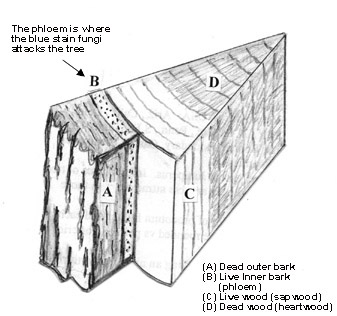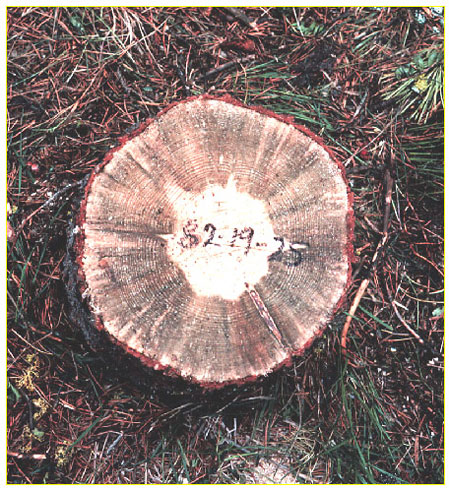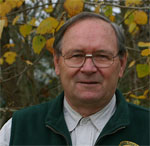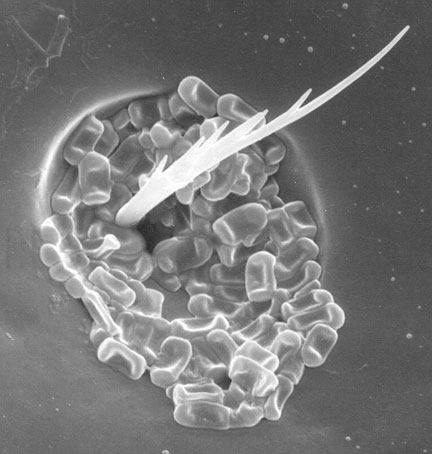Fungi: Not just a mushroom
 |
When we think of fungi, we often think of the obvious – mushrooms! However, mushrooms are just one type of fungi in a giant kingdom of diverse species. If it wasn’t for fungi, we might see a lot less mountain pine beetle around. The blue stain fungi Ophiostoma associated with mountain pine beetle greatly increases the success the beetle has in over-coming a tree’s defences, and breeding successfully.
What are Fungi?
Fungi are in a classification of their own. They are not plants, as they lack chlorophyll, and therefore do not manufacture their own food. They feed on dead organic matter, soil, feces and other living things. They are very important to the ecology of mountain park forests. “Micorrhizal” fungi get their food from the roots of living plants. They wrap their “hyphae” (or long thread-like strands of cells) around the roots of the plants and take food from them in the form of sugars & starches. These fungi also provide a service to the tree. They help the tree acquire water, and obtain phosphorus and nitrogen. They even help the tree fight off harmful bacteria.

Orange Mushroom. © Parks Canada |
Fungi biology
- Mycelium: soft, thready hyphae that spread through or around the food source. If you have seen mold, you have see mycelium.
- Carpophore: mushroom “head” that emerges into the air and sun. This is the reproductive equipment that gives off spores to form new fungi.
How do Blue Stain Fungi live?
Unlike Miccorhizal fungi, Blue stain fungi are not helpful to trees. In fact, they have evolved relationships with bark beetles like mountain pine beetle that allow them to travel from tree to tree on a special structure in the beetle's mouthparts, and feed on the living tissue (phloem) of the tree. After the beetle introduces the fungi to the tree, mycelia grow rapidly into the sapwood, slowing the movement of fluids and disrupting the tree’s defences against the invading beetles. Eventually the tree dies due to lack of moisture.

Diagram of a tree wedge showing the dead outer bark, the live inner bark (or phloem), the live wood (or sapwood) and dead wood (or heartwood). © Malcolm M. Furniss |
 Tree stump infected with blue stain fungi.
Tree stump infected with blue stain fungi.© Canadian Forest Service |
|
|
 |
Dr. Les Safranyik of the Canadian Forest Service talks about Blue Stain Fungi:
“The blue stain are the yeast like fungi, and they are pathogenic to living cells in trees. The blue stain fungus is carried by the mountain pine beetle in a special structure inside one of its mouthparts when they feed along the edges of the pupal chambers. They charge these so called mycangia with the spores of the fungi, and when they bore into new trees, the chewing action empties the spores into the tissues of the tree. The fungi then very quickly germinate and penetrate living cells, killing them, preventing these living cells from converting themselves into virtual factories for producing resin in response to the chewing action of the beetles as well as the irritation from the fungi. Hence, the association of the beetle with the fungus aids the beetles in establishment in the tree and the fungus itself benefits from this association by being carried to new food sources by the beetles. And this mutually beneficial association is call symbiosis.”
What’s in it for the Mountain Pine Beetle?
As the blue stain fungi grows rapidly into the phloem of the tree, it “clogs” the tubes that bring moisture up into the tree, and in so doing also disrupts the tree's ability to produce sap or “pitch”. This means the tree can’t defend itself against mountain pine beetle by catching the beetle in the sap. Therefore, the beetles are able to mine out galleries and lay eggs while avoiding the tree's defences.
- Date modified :
